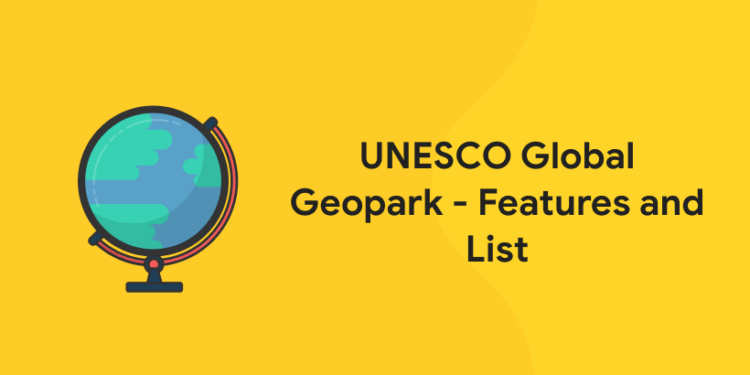Table of Contents
UNESCO Global Geoparks are single, unified geographical areas where sites and landscapes of international geological significance are managed with a holistic concept of protection, education and sustainable development. China is the country with the largest number of global geoparks. Notably there are not yet any global geoparks in the United States or South Asia and most of Africa.
In this article we will discuss about United Nations Educational, Scientific and Cultural Organization (UNESCO) and its list of Global Geoparks, it is an important topic for upcoming IAS Exam. For the ease of candidates preparing for the UPSC exam list of UNESCO Global Geoparks are listed below.
Attempt Free GK Mock test ! Download Entri App!
About UNESCO
- The United Nations Educational, Scientific and Cultural Organization (UNESCO) is an important program under the United Nations and is headquartered in Paris, France.
- UNESCO is the United Nations Educational, Scientific and Cultural Organization. It seeks to construct peace thru worldwide cooperation in Education, the Sciences and Culture.
- UNESCO’s programmes make a contribution to the success of the Sustainable Development Goals described in Agenda 2030, followed with the aid of using the UN General Assembly in 2015.
- UNESCO-IOC (Intergovernmental Oceanographic Commission) is main a worldwide attempt to set up ocean-primarily based totally tsunami caution structures as a part of an standard multi-danger catastrophe discount strategy. Recently, UNESCO-IOC accepted the popularity of groups of Odisha viz., Venkatraipur and Noliasahi as Tsunami Ready Communities.
- It has 193 Members and eleven Associate Members. India joined UNESCO in 1946.
- In 2019, america and Israel officially end UNESCO. It is situated in Paris, France.
LIST OF UNESCO GLOBAL GEOPARKS
1: Who was the first woman President of India?
| Country/Territory | UNESCO Global Geopark |
| Austria |
|
| Belgium |
|
| Brazil |
|
| Canada |
|
| Chile |
|
| China |
|
| Croatia |
|
| Cyprus |
|
| Czechia |
|
| Denmark |
|
| Ecuador |
|
| Finland |
|
| France |
|
| Germany* |
|
| Greece |
|
| Hungary* |
|
| Iceland |
|
| Indonesia |
|
| Iran (Islamic Republic of) |
|
| Ireland* |
|
| Italy |
|
| Japan |
|
| Luxembourg |
|
| Malaysia |
|
| Mexico |
|
| Morocco |
|
| Netherlands |
|
| Norway |
|
| Nicaragua |
|
| Peru |
|
| Poland* |
|
| Portugal |
|
| Republic of Korea |
|
| Romania |
|
| Russian Federation |
|
| Serbia |
|
| Slovakia* |
|
| Slovenia* |
|
| Spain |
|
| Sweden |
|
| Tanzania |
|
| Thailand |
|
| Türkiye |
|
| United Kingdom of Great Britain and Northern Ireland* |
|
| Uruguay |
|
| Viet Nam |
|
Features of UNESCO Global Geoparks
The important features of UNESCO Global Geopark are detailed below:
Management:
- These are controlled through way of way of a frame having felony existence identified below national legislation.
- Maintenance and preservation of Geoparks by involving local communities and combining conservation with sustainable development of the region.
- It desires to be noted that UNESCO Global Geopark repute does not recommend guidelines on any monetary interest interior a UNESCO Global Geopark wherein that interest complies with indigenous, network, nearby and/or national legislation.
Visibility:
- Geoparks are sustained through geo tourism activities like excursions, nature trails, guided tours, trekking and educational meets.
Networking:
- Cooperating with the network people (bottom-up approach) dwelling withinside the geopark area and with unique UNESCO Global Geoparks through the Global Geoparks Network (GGN).
- GGN, of which club is compulsory for UNESCO Global Geoparks, is a legally constituted not-for-income organisation with an annual club fee. It was based totally absolutely in 2004.
Designation Period:
- A UNESCO Global Geopark is given this designation for a length of 4 years and then the functioning and fantastic of every UNESCO Global Geopark can be very well re-tested in the course of a revalidation process.
Attempt Free GK Mock test ! Download Entri App!
Free UPSKILLING Courses!
Take your first step toward mastering in-demand skills, acing interviews, and securing top-tier jobs with Entri's free upskilling courses.
Start Learning!About UNESCO Global Geoparks
At present there are 161 UNESCO Global Geoparks in 44 countries across the world, India is yet to have one of its own. UNESCO Global Geoparks single, unified geographical areas of international geological significance, and are managed with a holistic concept of protection, education, and sustainable development. UNESCO’s work with geoparks began in 2001. In 2004, 17 European and 8 Chinese geoparks came together at UNESCO headquarters in Paris to form the Global Geoparks Network (GGN)(link is external) where national geological heritage initiatives contribute to and benefit from their membership of a global network of exchange and cooperation.
The 195 Member States of UNESCO ratified the creation of a new label, the UNESCO Global Geoparks, during the 38th General Conference of the Organisation since November 2015 and enhance recognition of the importance of managing outstanding geological sites and landscapes in a holistic manner. The Organization supports Member States efforts to establish UNESCO Global Geoparks all around the world.
- A UNESCO Global Geopark enhances awareness and understanding of key issues facing society, such as using our earth’s resources sustainably, mitigating the effects of climate change and reducing natural disasters-related risks.
- The creation of innovative local enterprises, new jobs and high quality training courses is stimulated as new sources of revenue are generated through geotourism, while the geological resources of the area are protected.
- A set of criteria as established by UNESCO must first be met for a geopark, as nominated by the corresponding government, to be included in the GGN:
- the existence of a management plan designed to foster socio-economic development that is sustainable (most likely to be based on agritourism and geotourism);
- demonstrate methods for conserving and enhancing geological heritage and provide means for teaching geoscientific disciplines and broader environmental issues;
- joint-proposals submitted by public authorities, local communities and private interests acting together, which demonstrate the best practices with respect to Earth heritage conservation and its integration into sustainable development strategies.
Global Geoparks Network (GGN)
- The Global Geoparks Network (GGN), of which membership is obligatory for UNESCO Global Geoparks, is a legally constituted not-for-profit organization.
- The GGN was founded in 2004 and is a dynamic network where members exchange ideas of best practice to raise the quality standards of a UNESCO Global Geopark.
- While the GGN as a whole comes together every two years, it functions through the operation of regional networks, such as the European Geoparks Network that meets twice a year to develop and promote joint activities.It is managed under the UNESCO’s Ecological and Earth Sciences Division.
- The first batch of members to the GGN were announced during the first International Conference on Geoparks in 2004.
- There are now GGN member sites situated in 5 of 7 continents and there being none currently in either Antarctica or Australasia.
Grab Study Materials to Strengthen your Knowledge in GK!! Register Here!
Global Geoparks vs Biosphere Reserves and World Heritage Sites
UNESCO Global Geoparks: Give international recognition for sites that promote the importance and significance of protecting the Earth’s geodiversity through actively engaging with the local communities.
Biosphere Reserves: Focus on the harmonised management of biological and cultural diversity.India has 12 biosphere reserves under the World Network of Biosphere Reserves (WNBR).
World Heritage Sites: Promote the conservation of natural and cultural sites of outstanding universal value. India has 38 world heritage sites, including 30 cultural properties, 7 natural properties and 1 mixed site.
UNESCO Global Geopark in India
India is among one of the countries which do not have Global Geopark registered and recognized under UNESCO Global Geopark list. It is coastal red sediment mounds located between Visakhapatnam and Bheemunipatnam. Visakhapatnam and 34 National Geological Monument Sites notified by the Geological Survey of India (GSI) were featured.
Erra Matti Dibbalu or the coastal red sediment mounds, which are sand dunes located between Visakhapatnam and Bheemunipatnam, have been chosen as India’s representation for UNESCO Geopark in 2020.
INTACH organised a strategy to create public awareness on geologically and culturally important spots in the region in July 2019. INTACH was founded in 1984 in New Delhi with the vision to spearhead heritage awareness and conservation in India.
Role of UNESCO Global Geopark
UNESCO Global Geoparks encompasses local communities and give them the idea to develop cohesive partnerships with the common goal of promoting the area’s significant geological processes, features, periods of time, historical themes linked to geology, or outstanding geological beauty.
UNESCO Global Geopark plays an important role in protecting our geological and natural heritage.
UNESCO Global Geoparks give response people about the need and sustainable use for natural resources, whether they are mined, quarried or harnessed from the surrounding environment, while at the same time promoting respect for the environment and the integrity of the landscape.
Attempt Free GK Mock test ! Download Entri App!
Download Entri App, Entri provides you effective learnings in a period of time with the help of expert teams and you can accomplish the goal with the Entri App. Start your preparation for your dream government job with Entri App. We provide a wide range of courses over different government exams. We are providing you the best platform for the preparations for every prestigious exam. Here you can get access to a number of mock tests and get daily practice GK and Current affairs questions.
For candidates preparing for competitive exams like Bank Exam, UPSC exam and other Government Exams. Static GK connotes general knowledge about the static facts, the facts that are never going to change in the future. Entri App provides you with the best knowledge in GK and coaches candidates on different exams in your local language.












